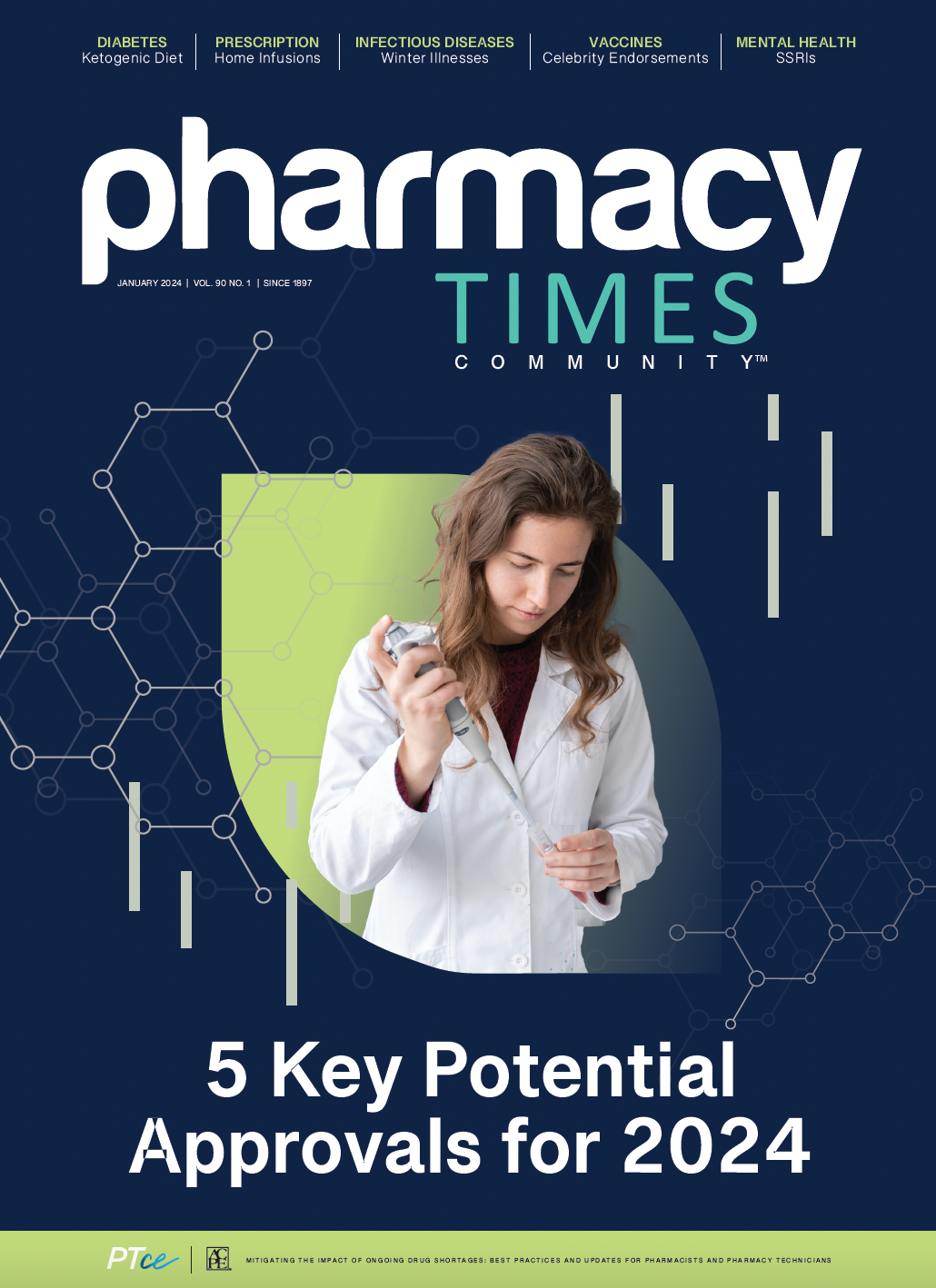Publication
Article
Pharmacy Times
5 Key Potential Approvals for 2024
Author(s):
Multiple sclerosis and pulmonary arterial hypertension are disease states expected to have new medications in the upcoming year
As medication experts, pharmacists are faced with the responsibility of staying up to date with not only current FDA approvals but also those on the horizon. There were 55 medications approved in 2023.1
Image credit: Jezper | stock.adobe.com

Pharmacists can stay ahead of the game when it comes to potential medication and vaccine approvals in 2024 by reviewing the literature. Phase 3 clinical studies are a good place to start because they are typically the basis for FDA approvals. From combination COVID-19/influenza vaccines to multiple sclerosis (MS) medications, 2024 has a variety of promising contenders.
MEDICATIONS
Glatiramer acetate (GA) Depot (Viatris; Mapi Pharma) is being studied as a treatment for MS and has a Prescription Drug User Fee Act (PDUFA) action date of March 8, 2024.2 GA Depot is the long-acting form of GA (Copaxone; Teva Pharmaceuticals), which is currently approved to manage MS. GA Depot is a 40-mg intramuscular injection administered once every 4 weeks for relapsing forms of MS, and it is slowly released for 30 days.3 Topline results showed GA Depot reduced relapse rate by approximately 30% compared with placebo (P = .0066).3 The most common adverse effects (AEs) were injection site reactions.3 Notably, the monthly injection may improve patient adherence as a more convenient option for managing MS symptoms.
Sotatercept (Merck) is an investigational medication for pulmonary arterial hypertension (PAH) World Health Organization Group 1, and the PDUFA date has been set for March 26, 2024.4 It is a first-in-class activin signaling inhibitor that was granted breakthrough therapy and orphan drug designations by the FDA.4 Sotatercept improves pulmonary blood flow by restoring balance in the bone morphogenetic protein pathway. The phase 3 STELLAR clinical study (NCT04576988) showed that sotatercept subcutaneous injection improved 6-minute walk distance (P < 0.001) compared with placebo.5 A starting dose of 0.3 mg/kg was administered followed by the target dose of 0.7 mg/kg 3 weeks later.5 The 0.7 mg/kg dose was given every 3 weeks for the study duration.5 The most common AEs reported were nosebleed, dizziness, and dilated blood vessels.5 With a novel mechanism of action, sotatercept may provide more treatment options for PAH.
Lifileucel (Iovance Biotherapeutics) is a biologic currently under review by the FDA for the treatment of advanced melanoma.6 As a first-in-class polyclonal tumor-infiltrating lymphocyte therapy, lifileucel works by using a unique technology to identify and target cancer cells.6 The PDUFA action date was extended to February 24, 2024, due to resource constraints.6 The C-144-01 phase 2 clinical trial (NCT02360579) revealed a clinically meaningful objective response rate of approximately 31%, including both partial and complete responses, to lifileucel therapy.7 The most common treatment-emergent AEs (TEAEs) were thrombocytopenia, febrile neutropenia, and anemia.7 The phase 3 TILVANCE-301 clinical trial (NCT05727904) is underway to serve as a confirmatory study evaluating therapy with lifileucel in combination with pembrolizumab (Keytruda; Merck) compared with pembrolizumab monotherapy for advanced melanoma.8
VACCINES
With COVID-19 and influenza cases and hospitalizations increasing across the US, it’s critical for patients to receive immunizations against these diseases.9,10 Although these immunizations are available separately and can be administered at the same visit, combination COVID-19/influenza vaccines may enhance adherence by providing the convenience of 1 shot.11 Pfizer released top-line data from its phase 1/2 study (NCT05596734) of the mRNAbased combination vaccine, which revealed participants demonstrated robust immune responses to influenza A, influenza B, and SARS-CoV-2 strains.12 Participants included healthy adults aged 18 to 64 years,12 and the phase 3 clinical trial is expected to begin in the coming months. The combination vaccine has received fast track designation from the FDA, and a decision could be made in 2024 regarding approval status.13 Additionally, the safety profile was consistent with that of Pfizer’s COVID-19 vaccine.12
Although respiratory syncytial virus (RSV) cases appear to be leveling off across the US, there are vaccines that can help prevent this respiratory illness.14 RSVPreF3 (Arexvy;GSK) and RSVpreF (Abrysvo; Pfizer) were the first vaccines approved for patients 60 years and older.15 RSVpreF is also approved as a maternal RSV vaccine. Moderna’s RSV vaccine (mRNA-1345) could join those as an additional option, with a PDUFA action date expected in April 2024.16 The mRNA-1345 RSV vaccine was developed with the same technology as Moderna’s COVID-19 vaccines.17 Granted both breakthrough therapy and fast track designations by the FDA, mRNA-1345 is being investigated for prevention of RSV lower respiratory tract disease (LRTD) in adults 60 years and older.16 The ConquerRSV phase 3 clinical trial (NCT05127434) evaluated approximately 37,000 adults aged 60 years and older.16 Vaccine efficacy (VE) against RSV-LRTD with 2 or more symptoms was 83.7% (P <.0001).16 Additionally, VE against RSV-LRTD with at least 3 symptoms was 82.4% (P = .0078).16 Most AEs were mild, and commonly reported AEs included injection site pain, fatigue, headache, myalgia, and arthralgia.
CONCLUSION
Staying abreast of upcoming drug and vaccine approvals can be challenging, but it is a key responsibility for pharmacists. Not only should pharmacists be knowledgeable to educate patients and even other clinicians about these new options, but some medications and vaccines could require preparation in the pharmacy to properly store and dispense. Continuing education, staying up to date with the literature, and checking the FDA website can all help pharmacists keep up with these fast-moving developments.
About the Author
Jennifer Gershman, PharmD, CPH, PACS, is a drug information pharmacist and Pharmacy Times contributor who resides in South Florida.
References
- Novel drug approvals for 2023. FDA. Updated December 6, 2023. Accessed December 4, 2023. https://www.fda.gov/drugs/newdrugs-fda-cders-new-molecular-entities-and-new-therapeuticbiological-products/novel-drug-approvals-2023
- Viatris and Mapi Pharma announce FDA acceptance of new drug application filing for GA Depot for the treatment of relapsing forms of multiple sclerosis. News release. Viatris. August 7, 2023. Accessed December 4, 2023. https://newsroom.viatris.com/2023-08-07-Viatris-and-Mapi-Pharma-Announce-FDAAcceptance-of-New-Drug-Application-Filing-for-GA-Depot-forthe-Treatment-of-Relapsing-Forms-of-Multiple-Sclerosis
- Miller AE, Popper L, Berger R, et al. Results of a phase III, multinational, double blind, placebo-controlled study in subjects with relapsing forms of multiple sclerosis to assess the efficacy, safety and tolerability of GA Depot, a long-acting IM injection of glatiramer acetate, administered once every four weeks. Presented at: ACTRIMS Forum 2023; February 23-25, 2023; San Diego, CA. Accessed December 4, 2023. https://www.abstractsonline.com/pp8/#!/10822/presentation/189
- Merck receives priority review from FDA for new biologics license application for sotatercept, an activin signaling inhibitor to treat adults with pulmonary arterial hypertension (PAH). News release. Merck. September 28, 2023. Accessed December 4, 2023. https://www.merck.com/news/merck-receives-priorityreview-from-fda-for-new-biologics-license-application-forsotatercept-an-activin-signaling-inhibitor-to-treat-adultswith-pulmonary-arterial-hypertension-pah/
- Hoeper MM, Badesch DB, Ghofrani HA, et al. Phase 3 trial of sotatercept for treatment of pulmonary arterial hypertension. N Engl J Med. 2023;388(16):1478-1490. doi:10.1056/NEJMoa2213558
- U.S. Food and Drug Administration updates Prescription Drug User Fee Act (PDUFA) action date for lifileucel for the treatment of advanced melanoma. News release. Iovance Biotherapeutics. September 14, 2023. Accessed December 5, 2023. https://ir.iovance.com/news-releases/news-release-details/us-foodand-drug-administration-updates-prescription-drug-user
- Chesney J, Lewis KD, Kluger H, et al. Efficacy and safety of lifileucel, a one-time autologous tumor-infiltrating lymphocyte (TIL) cell therapy, in patients with advanced melanoma after progression on immune checkpoint inhibitors and targeted therapies: pooled analysis of consecutive cohorts of the C-144-01 study. J Immunother Cancer. 2022;10(12):e005755. doi:10.1136/jitc-2022-005755
- Study to investigate lifileucel regimen plus pembrolizumab compared with pembrolizumab alone in participants with untreated advanced melanoma. ClinicalTrials.gov. Updated December 5, 2023. Accessed December 5, 2023. https://clinicaltrials.gov/study/NCT05727904
- COVID data tracker. CDC. Updated November 27, 2023. Accessed December 5, 2023. https://covid.cdc.gov/covid-datatracker/#datatracker-home
- Weekly U.S. influenza surveillance report. CDC. Updated December 1, 2023. Accessed December 5, 2023. https://www.cdc.gov/flu/weekly/index.htm
- Getting a flu vaccine and other recommended vaccines at the same time. CDC. November 2, 2023. Accessed December 5, 2023. https://www.cdc.gov/flu/prevent/coadministration.htm12.
- Pfizer and BioNTech announce positive topline data for mRNA-based combination vaccine program against influenza and COVID-19. News release. Pfizer. October 26, 2023. Accessed December 5, 2023. https://www.pfizer.com/news/press-release/press-release-detail/pfizer-and-biontech-announce-positivetopline-data-mrna
- Bourla A. Fireside chat - 41st annual J.P. Morgan Healthcare Conference. January 9, 2023. Accessed December 5, 2023. https://s28.q4cdn.com/781576035/files/doc_downloads/2023/01/PFEFireside-Chat-Slides-(01.09.23).pdf
- RSV national trends. CDC. Updated December 7, 2023. Accessed December 5, 2023. https://www.cdc.gov/surveillance/nrevss/rsv/natl-trend.html
- RSV vaccination for older adults 60 years of age and over. CDC. Updated August 30, 2023. Accessed December 5, 2023. https://www.cdc.gov/vaccines/vpd/rsv/public/older-adults.html
- Moderna expands the field of mRNA medicine with positive clinical results across cancer, rare disease, and infectious disease. News release. Moderna. September 13, 2023. Accessed December 5, 2023. https://investors.modernatx.com/news/news-details/2023/Moderna-Expands-the-Field-of-mRNAMedicine-with-Positive-Clinical-Results-Across-Cancer-Rare-Disease-and-Infectious-Disease/default.aspx
- Moderna announces global regulatory submissions for its respiratory syncytial virus (RSV) vaccine, mRNA-1345. News release. Moderna. July 5, 2023. Accessed December 5, 2023. https://investors.modernatx.com/news/news-details/2023/Moderna-Announces-Global-Regulatory-Submissions-For-Its-Respiratory-Syncytial-Virus-RSV-Vaccine-MRNA-1345/default.aspx






